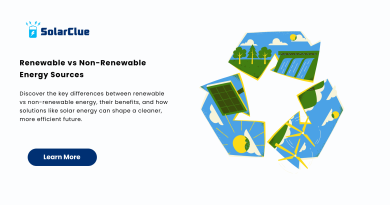Overcoming the Barriers to Renewable Energy Expansion in India
India is at a crucial juncture in its clean energy journey. While progress has been made, the road to a fully sustainable future still faces numerous roadblocks. With ambitious goals on the horizon, especially the 2030 climate targets, it’s essential to understand the key barriers to renewable energy expansion and how to overcome them. From infrastructure challenges to policy gaps, addressing these issues is the only way to realize India’s full green energy potential.
The role of renewable energy in India goes beyond just decarbonization. It directly impacts the nation’s economy, energy security, and social equity. India must not only ramp up capacity in solar, wind energy, and other clean sources but also improve its energy efficiency to create a truly sustainable ecosystem. This blog dives into the real issues holding India back and what must be done to unlock a cleaner future.
Table of Contents
- 1 The Urgency to Accelerate Renewable Energy Adoption
- 2 The Reality Behind Renewable Energy Cost
- 3 Challenges Facing Discoms and Power Distribution
- 4 Demand-Side vs. Supply-Side Approaches
- 5 Importance of Time-of-Day Pricing
- 6 Socializing Costs and Its Long-Term Impact
- 7 Greenwashing and Renewable Energy Accounting
- 8 The Role of Energy Storage and RTC Bids
- 9 Regulatory and Policy Framework Needs
- 10 Public Perception and Mindset Shifts
- 11 Pollution as the Root Issue
- 12 Financing the Renewable Transition
- 13 Conclusion: Charting the Way Forward
The Urgency to Accelerate Renewable Energy Adoption
India has pledged to install 500 GW of non-fossil fuel energy capacity by 2030. However, current deployment rates indicate that the country needs to triple its renewable installations to meet this ambitious target. The stakes are high—not just for India, but for the global climate scenario. Every delay in implementation leads to mounting emissions and missed economic opportunities.
When comparing India’s progress with global leaders like China, a stark contrast emerges. China, despite being the world’s biggest emitter, is also the largest investor in solar energy and wind energy. India, while showing consistent growth, is still lagging in both policy execution and infrastructure development.
Accelerating the adoption of renewable energy in India is not just a climate imperative—it’s a development necessity. More inclusive growth, improved air quality, and millions of new green jobs hinge on how fast and how well the country transitions away from fossil fuels. The central government has announced multiple schemes and subsidies, but on-ground implementation still remains a challenge.
From solar energy India initiatives like the PM Surya Ghar Muft Bijli Yojana to state-level solar tenders, the focus is clear—but it must be accompanied by smoother execution. Without active participation from state DISCOMs and local governments, even the best-laid plans may fall short.
The Reality Behind Renewable Energy Cost
One of the most common arguments in favor of solar power and wind energy is that they are cost-effective. While this is true in a general sense, the actual cost structure is far more nuanced. Most cost comparisons rely on a metric known as the Levelised Cost of Energy (LCOE), which often overlooks several critical factors.
LCOE does not account for storage requirements, grid balancing costs, or time-of-day variability. For example, solar energy is abundant during the day but virtually absent after sunset. This intermittency forces utilities to rely on backup systems—usually fossil fuel-based—adding to the overall system cost.
Moreover, solar power systems and wind turbines need robust transmission infrastructure to deliver electricity across long distances. Without adequate grid support, much of the generated power goes underutilized. This is where investment in modern smart grids and storage becomes essential.
The financial ecosystem also plays a role. Many solar energy companies India and wind energy companies India struggle to get long-term Power Purchase Agreements (PPAs) because state distribution companies (DISCOMs) are either financially weak or reluctant to commit due to perceived volatility. As a result, several projects that win government bids remain stuck in limbo.
On paper, renewable energy companies India offer clean and cheap power. But without solving these underlying structural issues, scaling clean energy will remain an uphill battle. That’s why the cost conversation must shift from per-unit price to overall solar energy efficiency and reliability.
Challenges Facing Discoms and Power Distribution

The power distribution sector remains one of the weakest links in India’s energy chain. Most state DISCOMs operate at a loss due to unsustainable pricing models and high transmission losses. While commercial and industrial users often pay more than the cost of supply, residential and agricultural sectors receive heavily subsidized electricity. This imbalance erodes financial viability.
In many cases, DISCOMs are hesitant to sign new PPAs with renewable energy companies India despite available capacity and competitive pricing. This reluctance stems from fears around grid reliability and cost recovery. Until the financial health of DISCOMs improves, large-scale expansion of solar and wind energy will remain constrained.
Demand-Side vs. Supply-Side Approaches
Government targets and large-scale auctions (supply-side strategies) are essential but insufficient without demand-side momentum. Consumers must have a reason—beyond environmental awareness—to switch to solar energy or adopt energy-efficient appliances. The integration of smart metering, time-based tariffs, and green building incentives can bridge this gap.
Changing consumer behavior through pricing signals and education can make the transition more organic and less reliant on mandates. Rooftop solar adoption, for instance, has seen a surge in urban areas, especially with initiatives promoted by platforms like solarclue.com, which simplify the process for homeowners and businesses.
Importance of Time-of-Day Pricing
Today, most consumers pay a flat rate for electricity, regardless of when they use it. However, the cost of supplying electricity varies significantly by time of day. Implementing time-of-day pricing can encourage consumers to shift their energy use to periods of high solar or wind energy availability.
This would reduce pressure on the grid during peak hours and improve the viability of solar power systems. For instance, if households run their washing machines or charge electric vehicles during the daytime, it would better align with solar production, enhancing solar energy efficiency.
Socializing Costs and Its Long-Term Impact
Incentives like net metering and free transmission for renewable producers are helpful in the early stages but become problematic at scale. When rooftop solar users draw power at night, it’s often coal-based energy, even though they banked solar energy during the day.
This creates hidden costs that are distributed across all consumers. California has already started limiting such benefits, and India may need to follow suit with reform-focused updates on subsidy allocation and grid usage charges.
Greenwashing and Renewable Energy Accounting
There’s a growing concern about greenwashing—when renewable energy claims are made without actual emission reductions. Banking mechanisms, where users send excess solar power to the grid and draw it back later, can create misleading carbon offset data.
This issue extends to sectors like green hydrogen, where the renewable energy used is often indirect. Strengthening verification mechanisms and real-time monitoring will be essential to maintain the credibility of India’s clean energy transition.
The Role of Energy Storage and RTC Bids
“Round the Clock” (RTC) and “Firm Dispatchable Renewable Energy” (FDRE) contracts are gaining traction. However, many still rely on over-sizing generation rather than integrating true storage solutions. Batteries, while expensive, are crucial for ensuring reliability.
India must create policies and financial incentives to fast-track battery storage adoption and hybrid systems. Without them, solar and wind energy will continue to be labeled as unreliable, stalling broader grid integration.
Regulatory and Policy Framework Needs
India’s energy policy is evolving but remains fragmented. Clear guidelines on grid interconnection, PPA terms, and dispute resolution can attract more private investment. Tariff structures must reflect true costs, including time-based pricing and location-specific surcharges.
Policy clarity will also reduce the risk perception for investors, especially in the rooftop solar power system sector where bureaucratic red tape can deter adoption.
Public Perception and Mindset Shifts
Public support is vital for any major transition. In India, solar energy is still seen as an expensive alternative by many. This perception must change through awareness campaigns, school-level education, and successful case studies.
Moreover, stakeholders need to accept that cleaner energy might come with higher costs in the short term—but offers huge savings in terms of health, environment, and energy independence in the long run.
Learning from Global Best Practices
Countries like Germany and California have shown both the possibilities and pitfalls of aggressive renewable energy expansion. India must learn from their experience, particularly around managing grid stability and evolving consumer incentives.
Creating dual targets—mandatory and aspirational—can also help balance feasibility with ambition. For more insights and educational resources, visit blog.solarclue.com.
Pollution as the Root Issue
While climate change garners more headlines, pollution is the immediate threat affecting millions of lives. Renewable energy in India, particularly solar and wind energy, can drastically reduce air pollution, contributing to better public health and reduced healthcare costs.
Reframing the energy debate to emphasize pollution reduction may resonate more with citizens and policymakers alike.
Financing the Renewable Transition
Financing remains a major hurdle. Massive investments are needed to overhaul infrastructure, build storage, and support innovation. Concepts like “Polluters Must Pay” can be institutionalized to fund this transition.
Green bonds, carbon markets, and international climate finance must be leveraged to fill the funding gap and support startups and SMEs in the solar energy companies India ecosystem.
Conclusion: Charting the Way Forward
India has the potential to become a global leader in renewable energy—but only if it acts fast and smart. The roadblocks are real but not insurmountable. Through regulatory reform, public awareness, and smart financing, India can not only meet its 2030 targets but also pave the way for a cleaner, healthier future.
Let’s transform challenges into opportunities and drive a sustainable revolution powered by solar, wind, and other clean energy solutions.
Want to make the switch to clean energy for your home or business? Start your journey with trusted resources at solarclue.com and explore in-depth guides at blog.solarclue.com. Let’s build a greener India—together.
FAQs
1. What is the biggest barrier to renewable energy in India?
The financial instability of DISCOMs, policy execution gaps, and grid limitations are the biggest challenges.
2. How can discoms become financially sustainable?
Through tariff reforms, reduction of losses, and better contract management with energy producers.
3. Is rooftop solar still a viable option?
Yes, especially with schemes like net metering and subsidies. However, regulatory clarity is needed.
4. What role does storage play in renewable energy?
Storage systems ensure grid reliability and help manage intermittent power from solar and wind energy.
5. How can India meet its 2030 renewable energy targets?
By accelerating policy implementation, improving infrastructure, and enhancing consumer participation.
Visit us today at solarclue.com to explore how you can be a part of India’s clean energy revolution. Let’s light up the future—one solar panel at a time. and if you want to explore our blog, visit our website.




